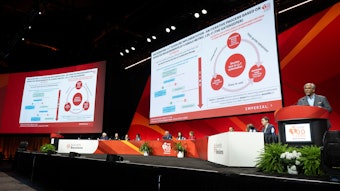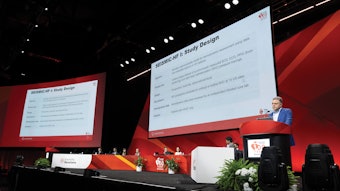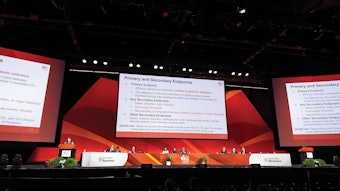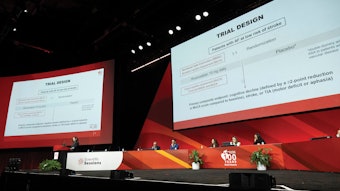LBS coverage (2020) | Clinical trials provide insights into CVD diagnosis in women, treatment for PCI and arrhythmia-associated bioprosthetic mitral valves

In Saturday’s Late-Breaking Science session, “Current Challenges in Coronary and Valve Disease,” three cardiac investigators revealed compelling data on alternative medications and multimodal imaging for patients in niche groups:
- Ticagrelor is not superior to clopidogrel in reducing periprocedural myocardial necrosis after high-risk elective PCI.
- Most women with myocardial infarction with non-obstructive coronary artery disease (MINOCA) have experienced true heart attacks, while one in five has an alternate diagnosis such as myocarditis.
- DOAC is noninferior to warfarin for patients with bioprosthetic valves with atrial fibrillation or flutter.
Ticagrelor versus clopidogrel
While percutaneous coronary intervention is widely recognized as an effective and safe procedure, some have questioned the value of elective PCI.
Frequent myocardial injury in stable patients can lead to an increased risk of future adverse cardiac events, including death.
The ALPHEUS trial investigated whether the PCI procedure could be made safer by treating patients with ticagrelor rather than clopidogrel.
“To date, clopidogrel with aspirin has been the recommended prevention strategy,” said Johanne Silvain, MD, PhD, lead investigator and director of coronary care at the Institute of Cardiology, Pitié-Salpêtrière Hospital in Paris. “Since ticagrelor is a more potent antiplatelet drug with proven efficacy in acute coronary syndrome patients, we hypothesized it would perform better than clopidogrel in elective PCI.”
In the first properly sized trial of its kind, ALPHEUS evaluated the two medications head to head in 1,883 stable coronary patients who underwent high-risk elective PCI. The randomized, multicenter, open-label trial took place from January 2017 to May 2020 in France and the Czech Republic with support from ACTION Group, an academic research organization.
The study group of 941 patients received ticagrelor with aspirin. The control group of 942 patients received clopidogrel with aspirin. Patients were evaluated for PCI-related type 4 (a or b) myocardial infarction or major myocardial injury and bleeding at 48 hours and 30 days.
The results were unexpected.
Despite its higher level of platelet inhibition, ticagrelor didn’t prove superior to clopidogrel in reducing ischemic complications within 48 hours, Dr. Silvain said. At 30 days, the clinical outcomes were similar, although minor bleeding and dyspnea were more frequent in the ticagrelor group.
Based on the ALPHEUS study, Dr. Silvain said clopidogrel associated with aspirin should remain the standard of care for PCI performed in stable coronary patients.
“There is no scientific data to use a stronger antiplatelet,” he said. “Ticagrelor is safe, but should be reserved for patients with acute coronary syndrome.”
Multimodal imaging in MINOCA
Myocardial infarction with non-obstructive coronary artery disease (MINOCA) affects up to 15% of heart attack patients and disproportionately strikes women, according to Harmony Reynolds, MD, director of the Sarah Ross Soter Center for Women’s Cardiovascular Research at the NYU Grossman School of Medicine.
“Some physicians doubt the likelihood of a true heart attack when there is less than 50% artery obstruction,” Dr. Reynolds said.
Dr. Reynolds led the four-year Women’s Heart Attack Research Program (HARP) funded by the AHA. The goal was to identify the causes of MINOCA using coronary optical coherence tomography and cardiac magnetic resonance imaging.
At multiple sites in the U.S. and Canada, a diverse group of 145 women with acute MI showing less than 50% blockage via diagnostic angiography were enrolled in the study.
All participants underwent OCT; 46% were diagnosed with a definite or possible culprit lesion, primarily plaque rupture, intra-plaque cavity and healed plaque.
Within one week of acute presentation, 116 of the participants also underwent CMR. The results were abnormal in 74%. A majority of the women presented with ischemic problems. Based on CMR, one in five of MINOCA patients had an alternate, non-ischemic diagnosis, such as myocardial infarction, myocarditis, takotsubo syndrome or another cardiomyopathy.
Each imaging technique provided useful diagnostic information. Together, the results were even more significant. Among the women receiving both OCT and CMR, a cause for heart attack was identified in 85%. In most cases, the location of the OCT artery findings matched up with the location of the MRI heart muscle abnormalities, proving plaque ruptures and erosions triggered the heart attack.
“The HARP study gives physicians clear support to perform advanced imaging studies in all MINOCA patients,” Dr. Reynolds said. “We shouldn’t guess at the cause of MI. We have the tools to find the problem, diagnose and treat.”
Direct oral anticoagulant not inferior to warfarin for patients with bioprosthetic mitral valves and atrial fibrillation or flutter
The primary results from RIVER, Rivaroxaban for Valvular Heart disease and atrial fibrillation, show that rivaroxaban is not inferior to warfarin — the standard of care anticoagulant for patients with bioprosthetic valves.
RIVER followed 1,005 patients from 49 sites in Brazil who had a bioprosthetic mitral valve and atrial fibrillation or flutter for 12 months. Patients were randomized 1:1 to rivaroxaban 20 mg once daily (15 mg daily in case of renal dysfunction) or warfarin dose-adjusted to an INR of 2.0-3.0.) The primary endpoint was a composite of death, major cardiovascular events (stroke, transient ischemic attack, systemic embolism, valve thrombosis or hospitalization for heart failure) or major bleeding over 12 months.
This is the largest trial to evaluate the safety and efficacy of direct oral anticoagulation in patients with bioprosthetic mitral valves and atrial fibrillation or flutter. Earlier trials of direct oral anticoagulation versus warfarin for atrial fibrillation or flutter included fewer than 200 patients in total with bioprosthetic mitral valves, said Otavio Berwanger, MD, PhD, chair of the RIVER Trial Executive Committee.
Clinicians have long used direct oral anticoagulants off label in patients with bioprosthetic mitral valves who have atrial fibrillation or flutter.
Patients who received rivaroxaban had a mean of 347.5 days free from the primary endpoint versus 340.1 days for warfarin. The difference was not statistically significant, Dr. Berwanger said. The incidence of stroke was lower in the rivaroxaban group (HR 0.25). Major bleeding and other serious adverse events were similar between the rivaroxaban and warfarin groups.
A subgroup analysis of 18.8% of RIVER patients with bioprosthetic mitral valve implantation within the prior three months showed a mean of 35.1 days longer without evidence of the primary outcome versus warfarin.
“The results from RIVER are consistent with previous evidence, including ROCKET and other pivotal trials of DOACs, and can inform clinical practice for patients with bioprosthetic mitral valves,” Dr. Berwanger said. “And for a subgroup of patients with a mitral valve replacement within the last three months, rivaroxaban was statistically and clinically superior to warfarin.”
RIVER was published simultaneously in the New England Journal of Medicine.











